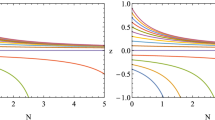Abstract
The present universe is dominated by repulsive dark energy. It is natural that the coupling between the dark energy and the attractive gravity has to be taken into account in studying the evolution of our universe. Here, we induce an evolution equation for dark energy–dark matter-coupled universe. The solutions of the dynamic equation provide a specific picture of cosmic evolution, which is well compatible with current observed evolution histories of both Hubble parameter and equation of state parameter of dark energy. In this picture, the already observed universe has undergone through three epochs—the epoch of equilibrium between gravity and dark energy at cosmological redshifts \(z>1\), the phase transition epoch at z between about 0.5 and 1, and the present acceleration epoch starting from \(z\simeq 0.5\). The expected matter-dominated deceleration epoch has not been seen yet, which requires future deep observations to look back upon more early universe.




Similar content being viewed by others
References
Zhang TJ, Ma C, Lan T (2010) Constraints on the dark side of the universe and observational Hubble parameter data. Adv Astron 2010:184284
Simon J, Verde L, Jimenez R (2005) Constraints on the redshift dependence of the dark energy potential. Phys Rev D 71:123001
Stern D, Jimenez R, Verde L et al (2010) Cosmic chronometers: constraining the equation of state of dark energy. I: H(z) measurements. J Cosmol Astropart Phys 1002:008
Moresco M, Cimatti A, Jimenez R et al (2012) Improved constraints on the expansion rate of the universe up to z ~ 1.1 from the spectroscopic evolution of cosmic chronometers. J Cosmol Astropart Phys 1208:006
Busca NG, Timothee D, James R et al (2012) Baryon acoustic oscillations in the Lyα forest of BOSS quasars. arXiv:1211.2616
Zhang C, Zhang H, Yuan S et al (2012) Four new observational H(z) data from luminous red galaxies Sloan digital sky survey data release seven. arXiv:1207.4541
Blake C, Brough S, Colless M et al (2012) The WiggleZ dark energy survey: joint measurements of the expansion and growth history at z < 1. Mon Not R Astron Soc 425:405–414
Chuang CH, Wang Y (2012) Modeling the anisotropic two-point galaxy correlation function on small scales and improved measurements of H(z), D_A(z), and β(z) from the Sloan digital sky survey DR7 luminous galaxies. arXiv:1209.0210
Farooq O, Ratra B (2013) Hubble parameter measurement constraints on the cosmological deceleration-acceleration transition redshift. arXiv:1301.5243
Planck Collaboration (2013) Planck 2013 results. XVI. Cosmological parameters. arXiv:1303.5076
Zhao GB, Crittenden RG, Pogosian L et al (2012) Examining the evidence for dynamical dark energy. Phys Rev Lett 109:171301
Milne E (1934) A Newtonian expanding universe. Q J Math 5:64–72
Milne E (1935) Relativity, gravitation and world structure. Clarendon Press, Oxford
McCrea W, Milne E (1934) Newtonian universe and the curvature of space. Q J Math 5:73–80
Riess A, Filippenko A, Kirshner R et al (1998) Observational evidence from supernovae for an accelerating universe and a cosmological constant. Astron J 116:1009–1038
Perlmutter S, Aldering G, Goldhaber G et al (1999) Measurements of Omega and Lambda from 42 high-redshift supernovae. Astrophys J 517:565–586
Weinberg S (1989) The cosmological constant problem. Rev Mod Phys 61:1–23
Li TP (2011) Constructing a robust universe with attraction-repulsion coupling and energy conservation. arXiv:1110.2678
Liu H, Li TP (2013) Missing completely of the CMB quadrupole in WMAP data. Chin Sci Bull 58:1243–1249
Acknowledgments
This work was supported by the National Natural Science Foundation of China (11033003).
Conflict of interest
The authors declare that they have no conflict of interest.
Author information
Authors and Affiliations
Corresponding author
About this article
Cite this article
Li, TP., Wu, M. Evolution of dark energy–dark matter-coupled expanding universe. Chin. Sci. Bull. 59, 4473–4477 (2014). https://doi.org/10.1007/s11434-014-0589-7
Received:
Accepted:
Published:
Issue Date:
DOI: https://doi.org/10.1007/s11434-014-0589-7




